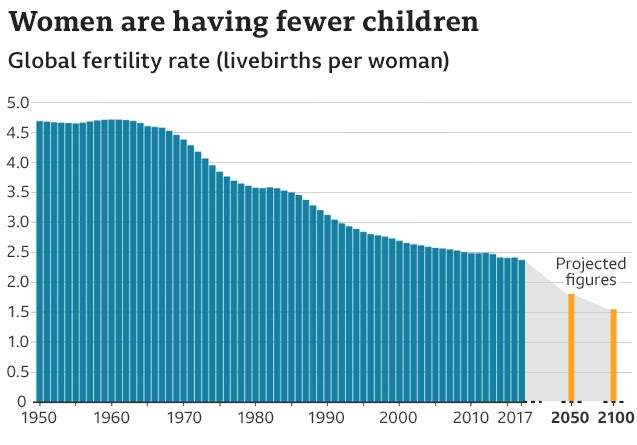Parenthood is one of the greatest gifts that has been bestowed upon human beings. The natural process of the human reproduction system gives us the scope to become parents and relish the joy of parenthood. However, in recent times fertility rate has taken a hit all over the world.
Economy and Falling Fertility
A prominent group of researchers at the University of Washington’s Institute of Health Metrics and Evaluation found out that the global fertility rate has dropped as much as 50% in recent years. In 1950, the global fertility rate was 4.7 which dropped down to 2.4 in 2017. These numbers (4.7, 2.4, etc.) indicate the average number of children a woman gives birth to. By studying the numbers, it is noticeable that the global fertility rate is dropping.

Source: University of Washington
Whenever the fertility rate drops below 2.1, the global population starts decreasing. Researchers at the University of Washington has projected that the fertility rate will further decline to below 1.7 by 2100. As a consequence, the world population will reach its peak at 9.7 billion around 2064, before declining down to 8.8 billion by the end of the 21st century.
There are many reasons behind this decline in global fertility rate. Some of them are not so pleasant as the adverse effect of many modern inventions is responsible for this. However, among the reasons, my focus is on women empowerment. Women’s empowerment is undoubtedly a blessing and has brought many positive changes in our lives. A decline in the global population growth rate or global fertility is one of the many benefits. As more women are getting educated and taking part in formal jobs, businesses, etc., they are getting less chance to give birth. Also, educated women are aware of the health risks associated with giving birth to too many children. So, they use contraceptives to avoid any unplanned pregnancy. Here’s an overview of women empowerment in Bangladesh:
1. The literacy rate of women is almost 60%.
2. The education rate is a little over 30%.
3. The number of school-going girls is increasing as it rose from 57% in 2008 to 95.4% in 2017.
4. Approximately 16.2 million Bangladeshi women were working in formal and recognized jobs in 2010. It increased by 2.4 million to 18.6 million in 2010.
5. Bangladesh secured 47th place among 144 nations in 2017 according to The Global Gender Gap Report. Though our Asian neighbors India, Sri Lanka, Nepal, Bhutan, and Pakistan stayed at 108, 109, 111, 124, and 143 positions individually.
As the fertility rate continues to decline, it has been predicted that most counties will see a shrinking population by the end of the century unless substantially liberal immigration policies are taken by these countries. This will prompt a significant shift in global economic power. Conversely, the number of inhabitants in sub-Saharan Africa is foreseen to significantly increase through the span of the century, the examination started, to 3.07 billion in 2100, up from 1.03 billion in 2017.
So, what does the future hold for us? According to Richard Horton, the editor-in-chief of The Lancet, there will be a far-reaching shift in the geopolitical power of the world. African and Arab countries will hold the most power and will shape the future. On the contrary, Asian and European countries will decline in power. By the end of this century, India, the USA, Nigeria, China will make the world multipolar. That’s why policymakers should emphasize immigration policies and the sexual and reproductive rights of women.
Now, naturally, the question arises why migration will become a so important factor. Well, the answer lies in two factors. First of all, the global fertility rate is declining. Secondly, life expectancy is increasing all over the world, thanks to revolutionary changes in the medical science field. As a result, the number of people aged over 80 will be 6 times more than the present number by the end of the century.
Table 1: Declination of working size population
Source: University of Washington
| Parameters | 2017 | 2100 | Increase/Decrease |
|---|---|---|---|
| The population of children under 5 years of age (In millions) | 681 | 401 | Decrease by 41% |
| The population of people over 80 years of age (In millions) | 141 | 866 | Increase by 614% |
Researchers have further predicted that the change in working size population will shift the size of global economies like a pendulum. It has been long predicted that China will have the world’s largest GDP by 2035, overtaking the USA. However, recent studies have shown that the USA will recuperate its top spot from China by 2098. China cannot avoid their destiny unless some quick and effective measures are taken to stabilize its declining fertility rate from 2050 onwards. Our neighbor India is predicted to maintain a stable working size population throughout the century. Also, it will have 3rd largest GDP in the world by the end of the 21st century, leaping from the current 7th spot. Nigeria will become a surprise addition to the list of top ten countries with the largest GDPs. Currently, Nigeria’s GDP is ranked 23rd in the world. But they are probably the only country in the world where the number of working size population will continue to rise throughout the century, resulting in a massive upsurge in the economy. That’s why Nigeria is predicted to have the world’s 9th largest GDP in 2100. Three powerhouses of Europe, Germany, France, and the UK will remain dominant even when the new century rolls in. However, Italy and Spain will drop down to 25th and 28th spots respectively.
Professor Ibrahim Abubakar of University College London remarked that if the results of the study were even 50% valid, then immigration will become a must for all the countries, not an option anymore. Because countries won’t be able to find working people locally anymore. So, they have to set lucrative and liberal immigration policies to find eligible people. So, it is high time we gave importance to the planned population movement and to our immigration policies. Otherwise, the future will hold something unpleasant for us.
Sources
1. CNBC
2. Dhaka Tribune
3. MOWCA Portal
4. INSIDER
5. The Lancet




